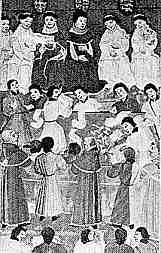 |
|
Modes of Reading in the Middle Ages (5) |
| The church was not the only body requiring Latin literacy in the middle ages. Law and bureaucracy were also recorded in Latin until the very gradual encroachment of vernacular languages in the late medieval period and beyond. While the chancellor of England was a churchman right through the middle ages, and the chancery clerks were drawn from major or minor orders, there were lay practitioners. Judges, lawyers and scriveners were drawn from the laity. There were those who recorded court cases and wrote them up in Latin, reading with their ears and writing with their hands. This required full and functional reading literacy in Latin. |
|
| A depiction of the Chancery court in action, as depicted in a manuscript in the Inner Temple Library. |
| There were others who had to deal with Latin documents, such as the sheriffs who were obliged to carry out the orders sent to them in writs. It is hard to know just how competent their literacy would have been, but the documents were short and the vocabulary limited. It was probably no harder than learning the acronyms generated by a modern government department. Ordinary members of the lay public who were involved in some legal process would seem to have had an interest in being able to read some Latin, but their actual competency is hard to assess. |
 |
Two aspects of documents such as charters are important in this context. One is that they arose from sworn oral testimony. Some such documents contain references to seeing and hearing the contents; reading with the eyes and ears. They contain lists of witnesses who could testify orally to the contents. Often the substantive content is minimal, and they record in the sketchiest of terms that a transaction has been carried out. |
| Charter of Ralph Cuningburgh granting lands to Byland Abbey (British LIbrary, add. charter 70691), by permission of the British Library. |
| The other is that they contain highly formulaic language, with the content set out in a standardised spatial plan. The term diplomatic is used to denote the form of words of a legal document, but it could equally be used to include the spatial arrangement of the textual components. A reader with only a simple phonetic concept of Latin could locate and decode such vital bits of information as personal or place names purely by knowing where they were supposed to be, without having the capacity to read and inwardly digest the whole document in a meaningful way. |
| Meanwhile, in the church of the later medieval period, liturgical texts became more comprehensive, so that every detail of the practice of the mass or divine office for every day of the year was entered into the missal or breviary. This entailed a great deal of rubric instruction, employing special abbreviations and what can only be called code. The ability to read standard Latin was not enough. Memory was aided by the use of a special symbolic language. |
|
A segment of rubric from a page of a Spanish breviary of around 1500, from a private collection. |
 |
Rubric instructions and a decorative initial from a Spanish gradual of around 1500, from a private collction. |
| Choir books such as the antiphoner or gradual had large clear text and musical notation for easy reading by the choir, which relied less on memory and more on literacy in both words and music. The coded rubric was for identification of the appropriate text for each particular occasion, or to indicate other aspects of the liturgy in process. |
In our time, we tend to conceive of literacy as an absolute, with reading and writing inextricably combined. We attempt, without notable success, to educate all members of society to the same standard of literacy. We think that everybody can be taught literacy in the same way, and classify those that cannot as suffering from some sort of medical condition or gross social deprivation. In the medieval era, reading literacy was not an absolute. There was always a broad range of levels and types of literacy, from those who had total competency in several languages, through those who were trained to understand certain kinds of texts and read them in particular ways, to those totally ignorant and obliged to seek out professional assistance if they required something to be read. There are interesting comparisons to be made in relation to the structure of text, layout and the use of visual imagery. There are also fascinating parallels between certain aspects of the medieval book and the use of modern media. The subject of writing is another story again. |
 previous page previous page |
 Reading, Writing, Hearing, Speaking and Remembering Reading, Writing, Hearing, Speaking and Remembering |
 The
Concept of Literacy The
Concept of Literacy |
|
 |
 |
 |



